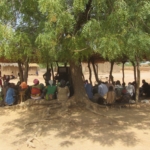


International Centre for Research in Agroforestry
8/2012—8/2013
The farming systems in the Sahel are characterized by low biomass production with crop residues collected to feed to the livestock leaving the lands exposed to soil erosion and degradation. In such context agroforestry parklands can play important role by providing green fodder that complements crop residues, fruit for human consumption and income generation, soil cover that reduces erosion and buffers climate change impacts. The project will start with a one year inception period that will used to build a functional team of the project and after collect, analyze and synthesize local and scientific knowledge on tree-crop-livestock interactions.
Enhance the knowledge on the ecosystem functions provided by parkland agroforestry to sustain the production in sorghum and millet-based systems in the face of variable and uncertain rainfall.Understand, assess, improve and support current development efforts to reduce human vulnerability in the Sahel through identification of current ‘best practices’ and promote the use of such approaches.Evaluate the performances of improved varieties of millet and sorghum in association with agroforestry parkland treesEvaluation of tree species for revegetation of earth bunds. Revegetation of earth bunds aims at stabilizing the earth bunds, reinforcing their efficiency in reducing runoff, increasing water infiltration and also to enhance fodder production that will be used to develop more relevant feeding strategies for livestock.
The survey of 50 households in Mali showed that the cropping system is based on the cultivation of cotton/cereals in a three-year rotation with chemical inputs (fertilizers and pesticides, etc.) applied on cotton and corn. The association of corn and millet/sorghum is also widely practiced. The production system is essentially rainfed using hand hoe or animal drawn implement for various tillage operations to reduce weed pressure and promote water infiltration (100% of the farmers surveyed). The average cereal yield value depends on a number of variables (soil fertility, rainfall, weed, bird, parasite and disease pressure) and fluctuates around 1000 kg ha-1. Due the high price of herbicides, their use is limited to cash crops (cotton and corn) as opposed to pure staple crops like millet and sorghum. The main socio-economic constraints of the households in Dougoumousso with regard to the farming system are: low purchasing power of farmers, high price of agricultural inputs compared to the price of millet/sorghum grain, inadequate access to equipment and agricultural loans.Four household categories have been found at Dougoumousso as following: not equipped (10%), low equipped (28%), well equipped (46%) and households with tractors (16%). This shows that 62% of the households in this village have a good level of equipment while 38% are not equipped. Such single criteria classification of the farmers is very convenient and has the advantage of being used beyond the limits of the project site in the country. Livestock sheep fattening is being practiced by 66% of farmers interviewed with feed composed of crop residues, tree fodder and cotton cake. These households also use animals in land preparation, tillage operations, transport, use the organic manure for crop production, etc. In addition, all the households (100%) produce organic matter through composting crop residues or garbage. All farmers interviewed (100%) in Dougoumousso participate in local organizations like the CPC (Cotton Producers Cooperative).Local knowledge on tree-crop-livestock interactions collected (four field visits with two focus group discussions and semi-structured interviews with 18 farmers), synthesized and made available by month 12 by conducting a literature review tree-crop-livestock interactions and local knowledge as well as baseline surveys on the same topics.Positive changes in practices to improve system productivity expressed by men during a focus group discussion held in Nobéré, Burkina Faso, 2013. – Agronomic changes: adoption of new technologies such as animal traction and improved seeder, improved crop variety with shorter cycle, pest control products, chemical fertilizers. – Improved technical knowledge through training on topics such as cropping and erosion control method.Positive changes discussed with women during a focus group discussion held in Nobéré, Burkina Faso, 2013. – Physical infrastructure: Access to water and Construction of a dam. – Market development: Increased market and price for groundnut and shea butter and an increased market for poultry.
